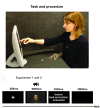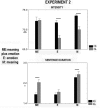The Effects of Meaning and Emotional Content of a Sentence on the Kinematics of a Successive Motor Sequence Mimiking the Feeding of a Conspecific
- PMID: 27242586
- PMCID: PMC4860854
- DOI: 10.3389/fpsyg.2016.00672
The Effects of Meaning and Emotional Content of a Sentence on the Kinematics of a Successive Motor Sequence Mimiking the Feeding of a Conspecific
Abstract
Aim: Do the emotional content and meaning of sentences affect the kinematics of successive motor sequences?
Material and methods: Participants observed video-clips of an actor pronouncing sentences expressing positive or negative emotions and meanings (related to happiness or anger in Experiment 1 and food admiration or food disgust in Experiment 2). Then, they reached-to-grasp and placed a sugar lump on the actor's mouth. Participants acted in response to sentences whose content could convey (1) emotion (i.e., face expression and prosody) and meaning, (2) meaning alone, or (3) emotion alone. Within each condition, the kinematic effects of sentences expressing positive and negative emotions were compared. Stimuli (positive for food admiration and negative for food disgust), conveyed either by emotion or meaning affected similarly the kinematics of both grasp and reach.
Results: In Experiment 1, the kinematics did not vary between positive and negative sentences either when the content was expressed by both emotion and meaning, or meaning alone. In contrast, in the case of sole emotion, sentences with positive valence made faster the approach of the conspecific. In Experiment 2, the valence of emotions (positive for food admiration and negative for food disgust) affected the kinematics of both grasp and reach, independently of the modality.
Discussion: The lack of an effect of meaning in Experiment 1 could be due to the weak relevance of sentence meaning with respect to the motor sequence goal (feeding). Experiment 2 demonstrated that, indeed, this was the case, because when the meaning and the consequent emotion were related to the sequence goal, they affected the kinematics. In contrast, the sole emotion activated approach or avoidance toward the actor according to positive and negative valence. The data suggest a behavioral dissociation between effects of emotion and meaning.
Keywords: emotion; human kinematics; meaning; prosody; spoken sentences; voice spectra.
Figures




References
-
- Chen M., Bargh J. A. (1999). Consequences of automatic evaluation: immediate behavioral predispositions to approach or avoid the stimulus. Pers. Soc. Psychol. Bull. 25 215–224. 10.1177/0146167299025002007 - DOI
-
- Ekman P., Friesen W. V. (1981). “The repertoire of nonverbal behavior: categories, origins, usage, and coding,” in Nonverbal Communication, Interaction, and Gesture ed. Kendon A. (The Hague: Mouton; ) 57–106.
LinkOut - more resources
Full Text Sources
Other Literature Sources

